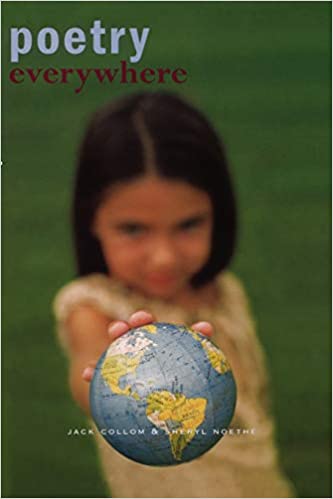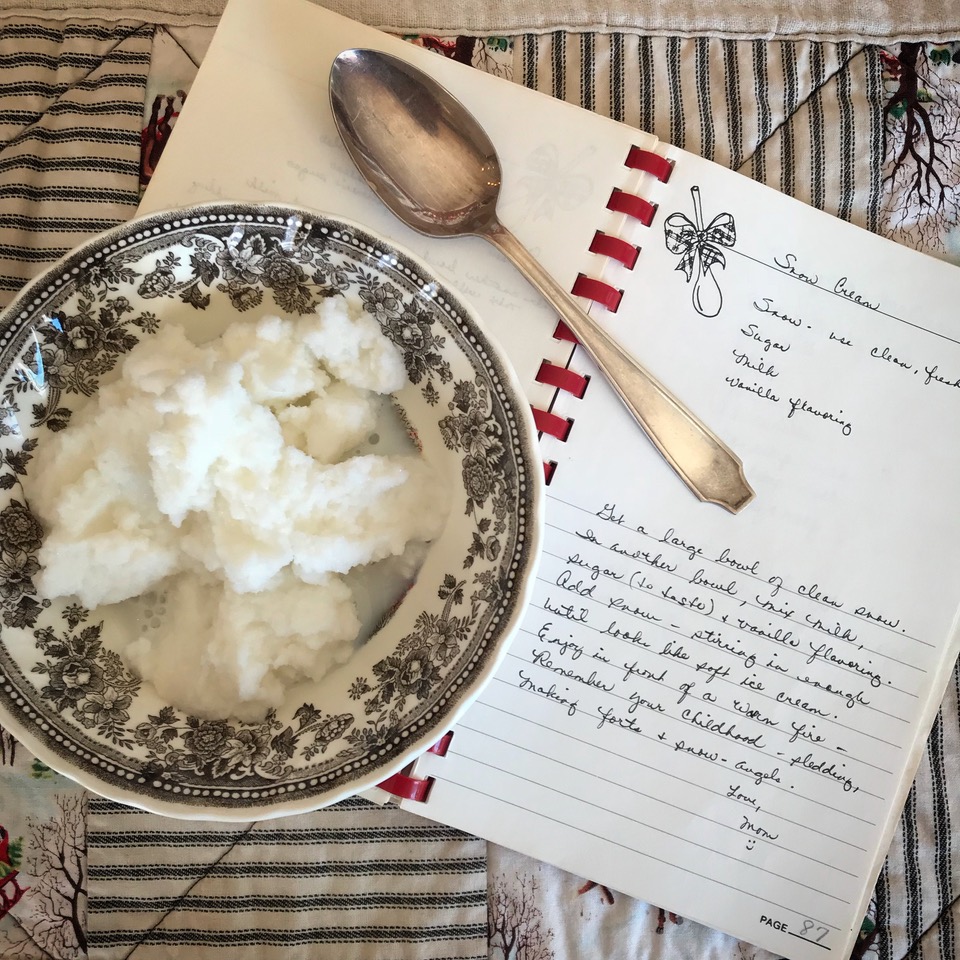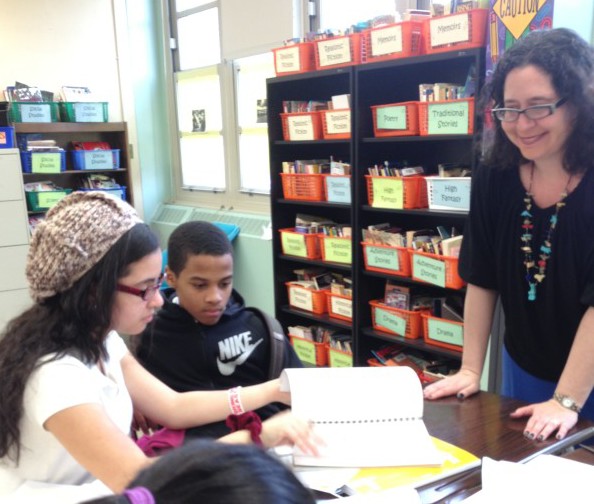This lesson is part of Writing Our Way Through: clear, fun, and engaging “lessons” for writing at home with young people.
Author/Teaching Artist: Sarah Dohrmann
Age Range: All ages
Materials: A handful of recipes (photocopies are ideal), paper, pens/pencils.
Overview
This lesson introduces the concept of metaphor by inviting young writers to create recipes for abstract things in life. In fact, it’s best if the chosen topic is for something abstract and not concrete: a recipe for love, for peace, for friendship.
I love this exercise because the creativity it brings out in children always surprises me, and it’s fun to watch young people delight in their own concoctions. To spice things up, I like to invite participants to share their poems at the end of the lesson without telling the listeners what the recipe is for; that way we can guess. And we are often right! This is not because the writers’ poems are obvious, though; it’s because children are really stretching their imaginations.
While we can’t actually bake or cook any real food in the classroom, I’ve always wished I could segue this lesson into some actual cooking. Hey, you can!
The Steps
1. Distribute some simple recipes—about two or three ought to do it.
2. Individually or in groups, ask participants to identify the following, in the order described:
- Underline all of the verbs in the recipe. This is where the recipe tells us to do something: simmer, bake, thaw, fry, slice, grate, etc. Can you find them all? Sometimes, depending on the age group, I also teach what the imperative is—the verb conjugation where the “you” is implied and someone’s telling you to do (or not to do) something.
- Now circle all of the measurements. Notice there are measurements not only for volume but also for time: teaspoon, pinch, 20 minutes, 1 hour, etc. If you want to keep things simple, just stick to measurements of volume (teaspoon, cup, ⅔ cup, ounces, etc.).
- Take a look at how the recipe is shaped overall. It might start with prep time and cook time; usually the first to be mentioned are all of the ingredients for the recipe; next are the steps; and finally might be some information on how to serve the dish to one’s guests. Note that you can imitate this format or you can just do your own thing. There’s no right or wrong.
3. After studying a couple recipes and making note of their main features as mentioned above, read the mentor poems. I read a collaborative poem that was published in Teachers & Writers’ book Poetry Everywhere, and often I follow it up with a poem by an adult and some examples of student poems. Between readings, I like to ask participants to comment on what surprises, delights, or confuses them in the poem. What do you notice?
4. Next, invite participants to make their own recipe poem. Sometimes coming up with the topic can be the hardest thing, so I have been known to have a hat or bag that I’ve filled with words. I also have used a magic wand once or twice in my life to jazz up the whole show and make the drawing of the topic to be a very big deal. As I mentioned, the topics I encourage are abstract: love, friendship, stress, delight, bliss, frustration, loneliness, hope, faith, confusion, trust—and so on.
5. Now, write your poem using strong recipe verbs along with measurements and prep time and steps along the way. How might you serve this thing? When I’m working with kids, I love to push them to use as many details as they can and to really use their imagination. For example, when I was helping a child to write a recipe for maturity, I told them they had to be realistic about their prep time. I mean, I’m in my 40s and I’ve only recently matured! (Though some parts of me are definitely undercooked.)
6. Share your recipes! If you don’t yet know the topic of others’ poems, why not have individuals read their poems aloud and have the listeners guess the subject? Finally, if you feel so inclined, cook something real and delicious. Serve warm.
Literary Terms, Forms, and Devices: Metaphor, List Poems, Sequencing.
Acknowledgments & References:

See also: “Recipe Poems” in Poetry Everywhere, edited by Jack Collom and Sheryl Noethe.
Mentor Text(s)
A collaborative poem published in Poetry Everywhere:
Cut into lengthwise slices: one earful of darkness.
Salt with cold snow falling at night.
Sing your heart out till you break a window. Sprinkle it on.
Add and brown slowly
green pearls upon your blue eyes bees flying near
fifty stars like your mind.
Simmer.
In the meantime take a trip to: Japan, the future, the sky, the sun.
Blow electricity through a telephone. Fold briskly into:
the flow of going backwards and the motion of going forward.
Beat until stiff but not dry:
one-at-a-time raindrops
falling stars when you don’t expect them
a sign on a store window that goes off and on.
Preheat paper to a breath in the air.
Sift the heart in your mind that beeps into a rainstorm just standing there.
Cover the whole thing with a zoo of heads.
Dust the top generously with:
cherries in the ears
flags blue and white
the sky scraping the skyscraper.
Bake the alphabet all talking at once until heated through
but don’t allow the snake in your room to know what to do.
The movie star with no fans may be cut into squares.
The dirt rushing in your face is used to line the pickup truck dish.
For dessert, peel the words shattered in a sort of system in your chest.
Play music from a black bear’s winter den and serve.
Student Poems
Wintertime
Start with 5 boots and then put in 1 set of gloves
and mix that together
then put in some bearsAfter that, you put some thermals in there
and you really mix them togetherNow you put some heaters inside to
make it really softNow you are ready to bake it
put it in the oven for 1 millisecond
at -20 degrees FahrenheitThen put some ice in and put it
in the freezer and leave it there
for 9 days
now you did itP.S. Put it on a plate
–Rafa D., Grade 3
P.P.S. Put in some wolves on the side
Peace
First, get a huge field
–Stella D., Grade 3
Pour a cup of guns in
The field, and beat it
As best as possible
Pour a lot of hugs, kisses,
Smiles, as many as you can
Get your hands on in the
Field. Let it sit a few days.
Then, drizzle sugar and
Truth on every inch.
Serve it equally, and if
There are any leftovers,
Give it to people who
Don’t have enough food
Sports
Prep time: 3 years
One cup of speed, agility, practice. Cook the skill for two hours
then rinse out the agility. Three cups of commitment and a tablespoon
of strength. Then put focus in a bowl and mix. One heated coach. And
one pinch of equipment.____________________________________
1 cup of strength
3 tablespoons of speed
½ cup of agility
2 ounces of practice
1 dash of commitment–Hugo S., Grade 3
Sarah Dohrmann is a Brooklyn-based writer of literary nonfiction whose work has appeared in Harper’s Magazine, Tin House Magazine, The Iowa Review, and New York, among others. She began teaching in the schools with T&W in 2001 and currently teaches at New York University; she also independently leads a personal nonfiction writing workshop called Diving Into the Wreck. After earning her MSW in June 2023, Sarah serves as a clinical social worker in the Domestic Violence Aftercare Program at University Settlement in New York City's Lower East Side.




